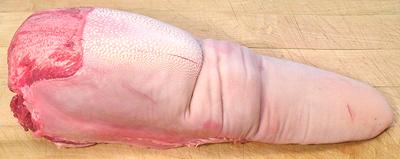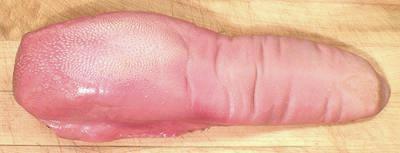Beef Tongue / Veal Tongue
 [Lengua de Res (Spanish)]
[Lengua de Res (Spanish)]
Beef tongue is a favorite for cold sliced appetizers and
also appears warm in various sauces and in Japan, grilled. You're not likely
to find tongues in the big chain supermarkets but markets serving ethnic
populations just about always have them, along with lamb and pig tongues.
The photo specimen weighed 3.8 pounds and was 14 inches long. Edible yield
was 64%, weight lost being in skin, fat and liquid.
More on Beef Innards
 Veal tongue differs from beef tongue in being less than 1/2 the weight,
more tender and with a milder flavor, and is from a dairy breed rather
than a meat bread. You needn't feel guilty for eating calf - blame it on
vegetarians eating all that cheese and yoghurt (see
Veal - Controversy). The photo specimen
weighted 1.55 pounds and was 11-1/2 inches long. It was fully cooked in
1-1/2 hours
.
Veal tongue differs from beef tongue in being less than 1/2 the weight,
more tender and with a milder flavor, and is from a dairy breed rather
than a meat bread. You needn't feel guilty for eating calf - blame it on
vegetarians eating all that cheese and yoghurt (see
Veal - Controversy). The photo specimen
weighted 1.55 pounds and was 11-1/2 inches long. It was fully cooked in
1-1/2 hours
.
More on Beef Innards
Buying:
Tongue is easy to find in many markets serving
ethnic populations. It is popular through Central and Eastern Europe as
well as the Balkan states and Portugal. It also appears in Persian and
Philippine cuisines and is widely used in Mexico and American Southwest,
particularly in tacos and burritos.
Prep:
Not much to do here. Just cut away any excess fat
at the bottom of the root end. Older and European recipes talk about
bones. This is not necessary in the U.S. because USDA regulations do not
allow the tongue to be cut that far back.
Cooking:
Tongue is most commonly simmered whole. It will
take roughly 1 hour for every pound the tongue weights. You can check by
running a sharp skewer through the thickest part - resistance should be
light and even all they way through - toughness at the center indicates
more cooking is necessary.
Rinse the tongue first in cold water, then in hot. Put it in a pot
with water to cover well (it will swell some). Add 1T salt and an 8-oz
onion quartered. When done, drain the tongue thoroughly and let it cool
just enough to handle it - then peel off the skin. This is much easier
hot than cold. Then the tongue can be chilled thoroughly and sliced -
it's much easier to slice thoroughly cold even if you intend to heat it
up again. The broth can be defatted and used in other recipes.
Beef tongue is also sometimes oven roasted. To prepare for this use
scald it in boiling water sufficiently for the skin to be peeled off
easily, then treat as any other beef roast of similar weight.
In Japan beef tongue is sliced very thin and grilled, a dish called
gyutan invented in 1948 to use beef parts discarded by US occupation
forces.
Health & Nutrition:
Keep in mind that
tongue is very fatty with most of the fat distributed within the flesh
and not removable. In our rather sedentary culture tongue should be
reserved as an occasional item, usually a party appetizer or such.
Some older and European recipes say to remove the bones at the root
of the tongue. This is not necessary in the United States, due to USDA
regulations aimed at preventing BSE (Bovine Spongiform Encephalitis -
mad cow disease).
Note in the beef tongue photo the skin has been removed from the root
end in compliance with USDA regulations to remove all traces of the tonsils
which are considered a possible carrier of BSE. This specimen is a bit
severe and most don't have that much skin removed. The veal tongue is not
so cut and skinned because cows that young are not considered a risk.
Harvesting tongues from cows over 30 months old is not allowed by the
USDA.
ab_tonguez 090229 - www.clovegarden.com
©Andrew Grygus - agryg@clovegarden.com - Photos
on this page not otherwise credited © cg1
- Linking to and non-commercial use of this page permitted
 Veal tongue differs from beef tongue in being less than 1/2 the weight,
more tender and with a milder flavor, and is from a dairy breed rather
than a meat bread. You needn't feel guilty for eating calf - blame it on
vegetarians eating all that cheese and yoghurt (see
Veal - Controversy). The photo specimen
weighted 1.55 pounds and was 11-1/2 inches long. It was fully cooked in
1-1/2 hours
.
Veal tongue differs from beef tongue in being less than 1/2 the weight,
more tender and with a milder flavor, and is from a dairy breed rather
than a meat bread. You needn't feel guilty for eating calf - blame it on
vegetarians eating all that cheese and yoghurt (see
Veal - Controversy). The photo specimen
weighted 1.55 pounds and was 11-1/2 inches long. It was fully cooked in
1-1/2 hours
.
 [Lengua de Res (Spanish)]
[Lengua de Res (Spanish)]